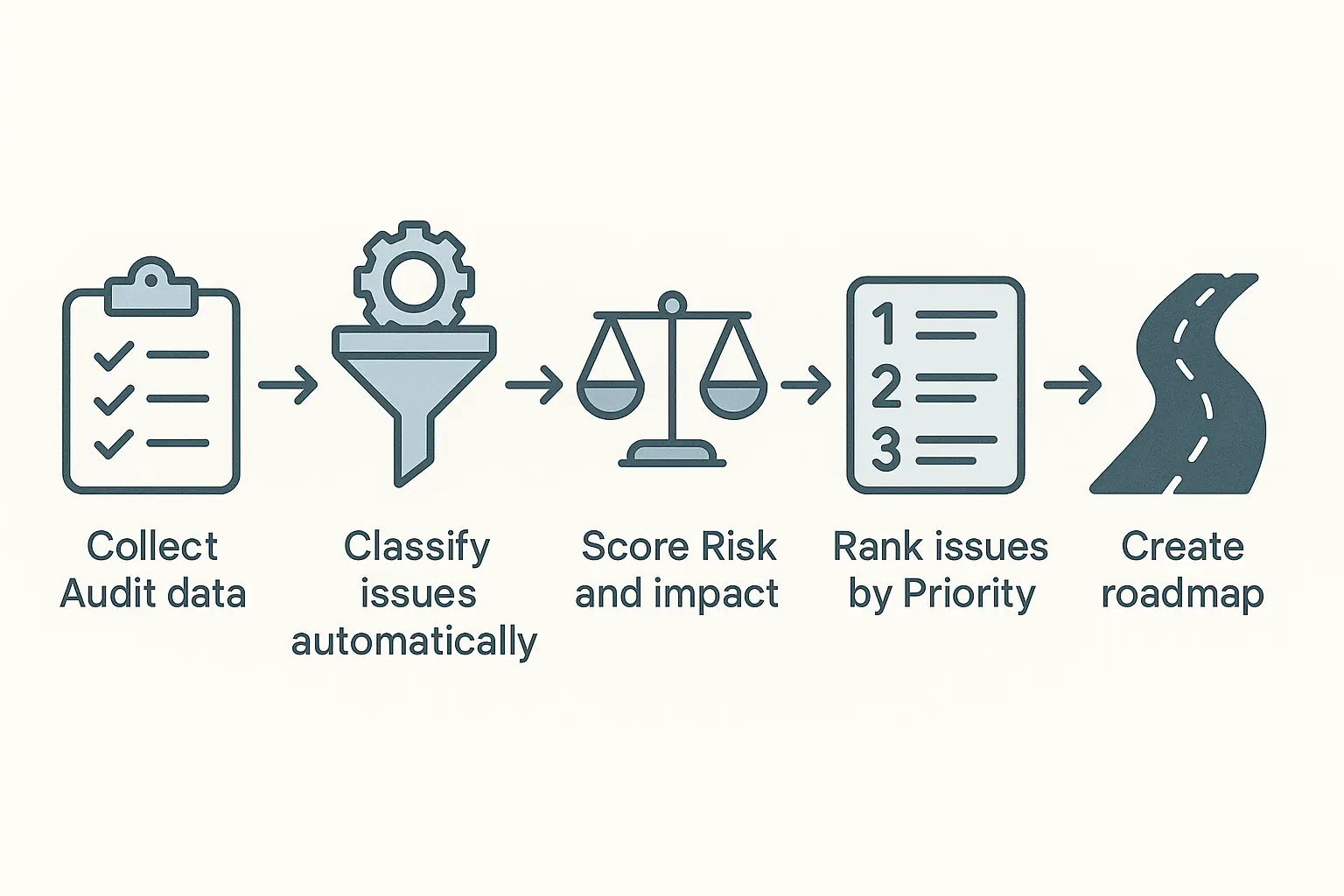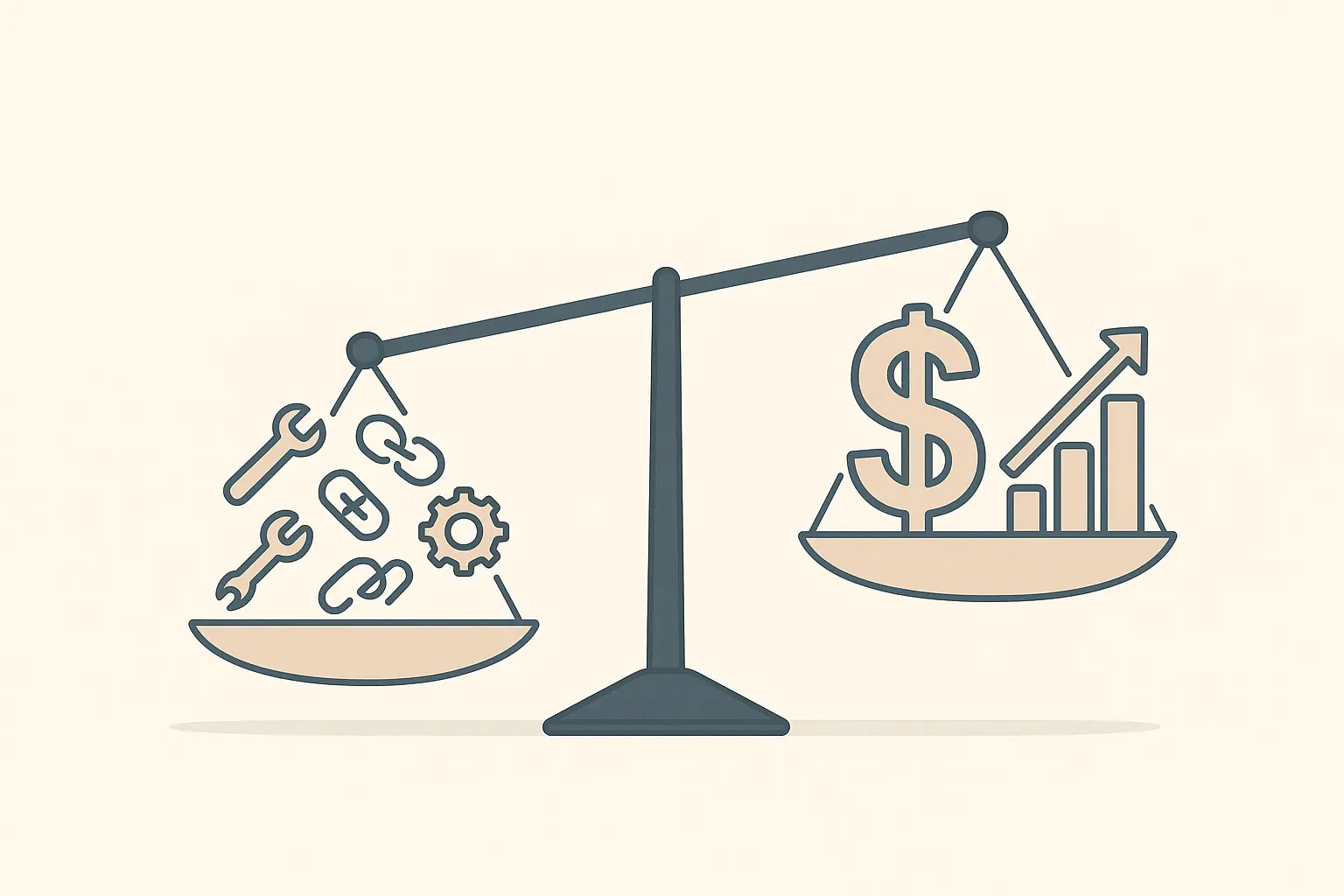You’ve been there. You run a comprehensive technical SEO audit for a new client, export the CSV, and your heart sinks. Thousands—sometimes hundreds of thousands—of issues stare back at you: broken links, missing meta descriptions, duplicate content warnings, schema errors, and a sea of red flags.
The client wants to know the plan. Your team wants to know where to start. And you’re left wondering: Where do we even begin?
This feeling of overwhelm is incredibly common. In fact, research shows that the average large site audit uncovers a staggering 157,000 technical SEO issues. It’s no surprise, then, that 78% of agencies report struggling with the prioritization of these fixes. Too often, the default approach is to start at the top of the list and work down, or simply to tackle the easiest fixes first.
But what if the 5,000th error on that list is quietly costing your client more revenue than the first 4,999 combined?
Fixing everything is impossible, and fixing things in the wrong order is inefficient. The key isn’t just to find errors; it’s to find the right errors to fix first. This requires shifting from a simple checklist to a strategic model based on two critical factors: risk and impact.
Beyond the Error Count: Why Not All Tech SEO Issues Are Created Equal
Think of a technical SEO audit like a doctor’s diagnostic report. A list of 50 minor bruises is less concerning than a single, severe fracture. Yet, many SEO reports present a 404 error on an old blog post with the same urgency as a sitewide canonicalization problem.
To move from merely flagging issues to driving real business results, we need to classify them more intelligently.
Understanding Risk: The Blast Radius of an Error
Risk in technical SEO refers to the potential negative scope of an issue. How widespread is the damage? We can generally break it down into three levels:
-
Sitewide Risk: These are the big ones. An error in the robots.txt file, incorrect implementation of hreflang tags on an international site, or a faulty canonical tag rule can affect every single page. These issues can decimate a site’s crawl budget, leading to widespread de-indexing and catastrophic traffic loss. Research highlights that sitewide issues like these can impact up to 90% of a site’s crawl budget.
-
Template-Level Risk: These issues are tied to specific page templates, like product pages, blog posts, or category pages. A broken schema markup on your client’s eCommerce product template, for instance, won’t break the whole site, but it could remove rich snippets for all their products, hurting CTR across a critical revenue-generating section.
-
Page-Specific Risk: This is the most common type of error, like a single broken internal link or a missing alt tag on one image. While important for site hygiene, these issues have a very small “blast radius” and rarely cause significant, immediate damage on their own.

Understanding Impact: Connecting Fixes to Business Goals
Impact measures how much fixing an error will move the needle on what your client actually cares about: traffic, leads, and revenue. An issue has a high impact if it affects:
-
High-Value Pages: Pages that drive the most conversions or rank for “money” keywords (e.g., checkout pages, service pages, top-performing blog posts).
-
User Experience (UX): Issues that directly frustrate users, like slow page speed or mobile usability problems, lead to high bounce rates and lost conversions.
-
Crawlability & Indexability: Problems that prevent search engines from finding, understanding, or indexing your client’s most important content.
The magic happens when you plot these two axes against each other.
The Risk vs. Impact Model: A Framework for Intelligent Prioritization
Instead of a never-ending to-do list, you can use a simple 2×2 matrix to categorize every technical issue. This framework instantly clarifies what your team should be working on right now, what can wait, and what might not be worth fixing at all.
Quadrant 1: Critical Fixes (High Risk, High Impact)
These are your immediate priorities. This quadrant is for sitewide or template-level issues that directly affect high-value pages. They are the SEO equivalent of a house fire.
Examples: A robots.txt file blocking search engines from crawling the entire /products/ section of an eCommerce site. Incorrect self-referencing canonical tags on all service pages, causing massive duplicate content issues.
Action: Drop everything. Fix these now.
Quadrant 2: High-Value Wins (Low Risk, High Impact)
These are your strategic opportunities. These issues are typically isolated to a few high-value pages, but fixing them can produce significant gains. They are quick, focused projects with a high return.
Examples: Improving the page speed of the top five landing pages. Fixing broken schema on the checkout funnel. Adding internal links from a high-authority blog post to a new, struggling service page.
Action: Schedule these immediately after the critical fixes are handled. These are often the tasks that make clients happiest because the results are so visible. Data even shows that fixing the top 10% of highest-impact errors can lead to a 25% increase in organic traffic.
Quadrant 3: Foundational Health (High Risk, Low Impact)
These are your background tasks. They are widespread issues that don’t directly impact money pages or core UX right now but create “technical debt” that could cause problems later.
Examples: A sitewide rule creating non-critical crawl errors on thousands of low-value archive pages. Inconsistent URL structure (e.g., trailing slash vs. non-trailing slash) across the site’s blog.
Action: Address these systematically over time. They are important for long-term site health but shouldn’t distract from more pressing issues. This is where an efficient SEO strategy makes a difference, ensuring technical health supports all other marketing efforts without monopolizing resources.
Quadrant 4: The Backlog (Low Risk, Low Impact)
These are the issues you might never fix. This quadrant is home to thousands of page-specific, low-impact errors. While it feels good to get to “zero errors,” the time spent here is often better used on higher-impact activities.
Examples: A broken external link on a blog post from 2015. A missing alt tag on a decorative image in the footer.
Action: Log them and ignore them unless you have spare capacity. Your team’s time is too valuable to spend here.

Putting the Model into Practice with Automation
Manually categorizing 157,000 issues into this framework is just as daunting as fixing them. This is where modern tools and processes become essential. The goal isn’t just to work smarter, but to automate the “smart” part.
By using systems that can automatically classify errors—identifying sitewide patterns, cross-referencing with analytics data to spot high-value pages, and flagging critical indexation blockers—you can transform your workflow. Studies show that automated classification tools can reduce prioritization time by up to 80%.
This allows your agency to spend less time digging through spreadsheets and more time on high-level strategy and client communication. By presenting your client with a prioritized plan based on risk and impact, you change the conversation. You’re no longer just an “error finder”; you’re a strategic partner focused on delivering measurable results.
For agencies looking to scale this capability, SEO automation is no longer a luxury; it’s a necessity for profitable growth. And for those who need to scale execution without adding headcount, trusted white label SEO services that operate on this strategic model can be a powerful extension of your team.

Frequently Asked Questions (FAQ)
What is technical SEO, really?
Think of technical SEO as the foundation of a house. It has nothing to do with the furniture (content) or the paint color (design), but if the foundation is cracked, the whole house is at risk. It involves making sure a website can be efficiently crawled and indexed by search engines, is secure, loads quickly, and provides a good user experience on all devices.
Why can’t we just fix every error the audit finds?
In a perfect world with unlimited time and budget, you could. But in reality, it’s about resource allocation. The time your team spends fixing a low-risk, low-impact error is time they could have spent optimizing a high-impact page that drives real revenue. Prioritization is about maximizing your return on effort.
What is a ‘crawl budget’?
Search engines like Google allocate a finite amount of resources to crawling any given website. This is its “crawl budget.” If your site is full of errors, duplicate pages, and redirect chains, Google’s crawler might waste its entire budget on unimportant pages and never even get to your new, critical service pages. Fixing high-risk technical issues helps preserve and optimize this budget.
How often should we run a technical SEO audit?
For most client sites, a deep audit is recommended quarterly, with automated weekly or monthly monitoring for critical issues. A major site redesign or migration always warrants a full pre-launch and post-launch audit.
From Overwhelmed to In Control
The next time you’re faced with a terrifyingly long list of technical SEO errors, don’t panic. By applying the Risk vs. Impact model, you can instantly bring order to the chaos, focus your team’s efforts where they matter most, and demonstrate strategic value that goes far beyond a simple audit report.
Ready to see how automation can streamline this process? Discover how a strategic partnership can help you deliver better results and build scalable, profitable SEO services.

